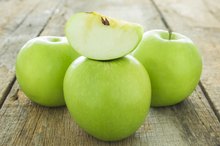What Is Tamarind Concentrate?
A tamarind is the brown, pod-shaped fruit of the native African tamarind tree. Also known as a tamarindo or an Indian date, tamarinds can be used fresh or dried, but are most often available in the United States as a canned concentrated pulp or processed into tamarind concentrate. Tamarind concentrate -- sometimes called tamarind paste -- has a mildly sweet flavor combined with an acidity that is similar lemon juice.
Nutritional Information
A typical commercial brand of tamarind concentrate is made from fresh tamarind pulp pureed with water, salt and sugar. A 1-teaspoon serving contains around 4 calories. Tamarind concentrate is low in fat and protein and high in carbohydrates, the majority of which are supplied by simple sugars from the fruit and the added sweetener. Tamarinds are naturally high in B vitamins such as thiamine and minerals such as magnesium and iron. Commercial tamarind concentrate, however, is high in sodium, with each teaspoon containing as much as 200 milligrams of sodium, or more than 8 percent of the amount of sodium a healthy adult should limit himself to each day.
Ways to Use
How to Replace Sugar With Evaporated Cane Juice
Learn More
Tamarind concentrate is traditionally used as a way to add a slightly sour bite to Middle Eastern, Thai and Indian dishes. Use a few spoons of the paste to balance the sweetness in chutney, to add depth of flavor to curry or pad thai and as a seasoning for pickled fish. Tamarind concentrate is used to flavor commercially prepared Worcestershire sauce and can be added to homemade barbecue sauces or meat and poultry marinades. Try dissolving a small amount of the concentrate in regular or carbonated water for your own version of tamarind juice, a drink popular in the West Indies.
Making Your Own
You can find tamarind concentrate at Indian or Asian markets, in the international foods section of some large grocery stores and through online retailers. If you can't find a brand you prefer or you want a low-sodium alternative, prepare your own tamarind concentrate at home from whole tamarind pods or a block of tamarind pulp. Soak the pulp in warm water for a minimum of 20 minutes, using 1 cup of water for every 3 ounces of the fruit. Mash the pulp, drain the water, press the mixture through a fine-mesh sieve and stir enough of the strained pieces of the fruit into the concentrate to yield a thick paste. The Latin Kitchen says homemade tamarind concentrate will last about one week in the refrigerator.
Substitutions in Recipes
Can I Eat Prosciutto Ham Without Cooking It?
Learn More
If you do not have tamarind concentrate on hand and need a quick substitute that mimics the sweet-and-sour flavor provided by the paste, the cooking experts at Nigella.com recommend mixing light brown sugar with an equal part of rice vinegar, white wine vinegar or lime juice. You can also use chopped dates and dried apricots mixed with lemon juice, an equivalent amount of Worcestershire sauce or a combination of amchur powder and lemon juice.
Related Articles
References
Resources
Writer Bio
Michelle Kerns writes for a variety of print and online publications and specializes in literature and science topics. She has served as a book columnist since 2008 and is a member of the National Book Critics Circle. Kerns studied English literature and neurology at UC Davis.









